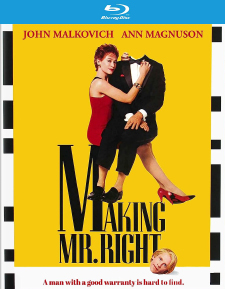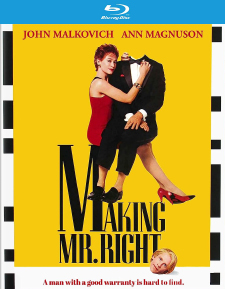Making Mr. Right (Blu-ray Review)

Director
Susan SeidelmanRelease Date(s)
1987 (March 7, 2023)Studio(s)
Orion Pictures/MGM (Kino Lorber Studio Classics)- Film/Program Grade: B-
- Video Grade: A-
- Audio Grade: A-
- Extras Grade: B
Review
What was in 1987 a novel twist on a sci-fi/fantasy chestnut today comes off as very dated and rather unsatisfying. Stories about a lifelike android, often the spitting image of its creator or spouse thereof, are as old as the movies, though rarely memorably so. There was, for instance, The Perfect Woman (1949), a mild British comedy in the Ealing mold. The short-lived television sitcom My Living Doll (1964-65), operated from a similar premise, with psychiatrist Bob Cummings entrusted to look after sexy android Julie Newmar.
In virtually all such films and TV shows, the android is female and the inventor or caretaker is a man, but in Making Mr. Right those roles have been reversed, with PR firm executive Frankie Stone (Ann Magnuson) becoming involved with experimental android Ulysses (John Malkovich), the creation and spitting image of its misanthropic inventor, Dr. Jeff Peters (also Malkovich).
The 99-minute film, written by Floyd Byars and Laurie Frank, has an unusually busy plot. Frankie accepts the task of selling Ulysses to the public prior to its launch into a deep space on a seven-year mission. Meantime, she is simultaneously a) juggling a relationship with ex-boyfriend and former client Steve Marcus, who is running for Congress; b) best friend Trish (Glenne Headly, then married to Malkovich), freaking out with anxieties after leaving her self-absorbed soap opera star husband, Don (Hart Bochner); and c) the upcoming wedding of her sister, Ivy (Susan Berman). Meanwhile, Dr. Peters is trying to fend off a co-worker, Sandy McCleary (Laurie Metcalf), anxious to date him.
Amidst all this activity, the insatiably curious Ulysses finds spending time with Frankie, with whom he quickly falls in love, far more interesting than the dry, pre-flight training sessions with Dr. Peters in the austere laboratory. He effectively escapes, hiding under some trash in the backseat of Frankie’s fire engine-red Chevy Corvair convertible.
What’s frustrating is that Making Mr. Right’s plot is so damn busy and overloaded with extraneous characters there’s precious little time to develop what’s supposed to be the heart of its story: the relationship between Frankie and Ulysses. Director Susan Seidelman’s previous film, Desperately Seeking Susan (1985), with Rosanna Arquette and Madonna, had been an unexpected hit ($27.3 million at the box office against a $5 million budget) and, like that film, Making Mr. Right exhibits an early MTV-influenced visual style. It’s bright with primary colors and stylized to a proto-Wes Anderson air of unreality, but with 36 years of hindsight, that look dominates the film at the expense of characterization.
For one thing, Ann Magnuson’s Frankie is all but defined by her wardrobe—she wears then-fashionable tight-fitting designer suits, skittering from scene-to-scene in high heels or tooling around in her cool convertible, but the movie audience never gets the chance to understand her as a character. She’s supposed to be the strong leader of a PR firm, but that’s only to service the plot, to provide the means for an outsider to get into close contact with Ulysses at the top-secret government-sponsored lab. After a short scene in her office, Frankie never does anything that remotely resembles public relations work and instead does very ‘80s-type things like frantically chasing her robot friend around a bustling shopping mall.
Her politician ex-boyfriend is nearly a cartoon character, and one never gets a sense of why she was ever attracted to him in the first place, or what she’s longing for in her life, particularly in her relationships with men. She’s supposed to fall in love with Ulysses by the end (of course), but there are only a few hints here and there why she might feel that way, certainly nothing that would seem to justify her tremendous grief when it looks like he’s finally being blasted off into space, lost in the stars.
Likewise, the various extraneous subplots exist solely to provide complications for Frankie and Ulysses, rather than contribute insight into any of the characters. The late Glenne Headly, sexy but otherwise wasted as best pal Trish, exists mainly to provide Ulysses with his first sexual encounter and for Frankie to have someone to bounce lines off of. Better is the nearly unrecognizable Laurie Metcalf as Sandy, who embarks on a disastrous “date” with Ulysses, mistaking him for Dr. Peters. It’s the funniest sequence in the film but her character’s fleeting happiness destroyed by one humiliation after another is vaguely mean-spirited. By the end the audience can’t help but feel sorry for this desperately lonely woman.
Indeed, Making Mr. Right probably would have worked a lot better had the female protagonist been a lowly, lonely receptionist at the lab—think Shirley MacLaine in The Apartment—or maybe even a cleaning lady who stumbles upon Ulysses during her night shift, a set-up that would have gotten the two characters together more quickly and naturally, and which would have allowed for more screentime together. That would have been far preferable to all the uninteresting material about scatterbrained Trish’s love-life, her soap opera star lover, the lame politician, etc.
One gets the sense of a lot of talent working beneath their abilities. Magnuson, Malkovich, Headly, and Metcalf are all terrific playing poorly-defined, underdeveloped characters. Malkovich, though handicapped with a thoroughly unreal hairpiece in both parts, comes off best, with his Ulysses as much unformed as childlike. All but hermetically sealed within the lab, he finds the world outside endlessly fascinating, curious about every little detail around him. Malkovich gives a carefully considered performance; for instance, his gait is just a wee bit off throughout, Ulysses walking like a very advance android, but nevertheless a machine, anticipating even the most high-tech walking robots of today.
In the best sense, Malkovich’s performance is reminiscent of Gregg Martell’s Neanderthal Man in Dinosaurus! (1960), an otherwise mediocre science fiction programmer. Martell, normally a minor player on films and TV, was by far the best thing about that film playing, like Martell, a puzzled, curious outsider—a reanimated primitive in that case—delightfully reacting to a world where absolutely everything is unfamiliar.
Making Mr. Right was previously released on Blu-ray (in November 2015) by Olive Films and, by all reports, that utilized a substandard video master. Kino’s new release offers a new 2K transfer that accurately reflects the bright 1.85:1 widescreen cinematography of Edward Lachman, and the DTS-HD Master Audio (2.0 stereo) is a good approximation of the original Dolby Stereo theatrical release. The image is sharp and up to contemporary standards of the time, including a few awful optical effects (the brief scenes in space; the opticals combining the two Malkoviches are excellent). Optional English subtitles are provided and the disc is Region “A” encoded.
Also in stark contrast to Olive’s no-frills release, Kino’s is fairly packed with strong extra features: a new audio commentary by director Seidelman and Magnuson; separate new on-camera interviews with both (Maguson’s running 14:45 and Seidelman’s 15:44); and a likewise 2K remastered trailer (2:08).
Making Mr. Right has a quartet of very good performances, an interesting visual design, and exhibits intelligence and some cleverness here and there, but is lacking in terms of fleshing out its protagonist into a character one can relate to as a human being and care about. Worth seeing once, but a disappointment overall.
- Stuart Galbraith IV

